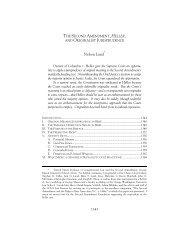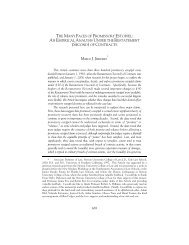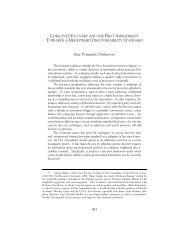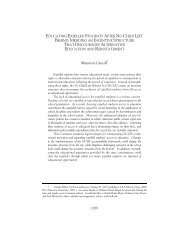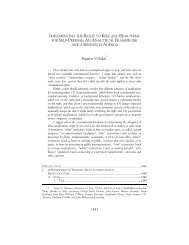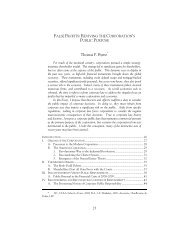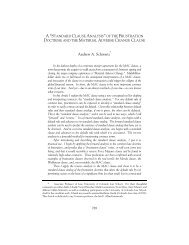Sonia K. Katyal - UCLA Law Review
Sonia K. Katyal - UCLA Law Review
Sonia K. Katyal - UCLA Law Review
You also want an ePaper? Increase the reach of your titles
YUMPU automatically turns print PDFs into web optimized ePapers that Google loves.
1634 57 <strong>UCLA</strong> LAW REVIEW 1601 (2010)<br />
In 1999, the original group won before the Trademark Board, which<br />
cancelled the mark on the grounds that the trademarks “may be disparaging of<br />
Native Americans” and “may bring Native Americans into contempt or disrepute.”<br />
151<br />
In its opinion, the court cited the testimony of one expert who had<br />
argued that the term remains disparaging as “an artifact of an earlier period<br />
during which the public at large was taught to believe that American Indians<br />
were a backward and uncivilized people” and also cited a variety of dictionary<br />
definitions that noted the offensive or disparaging nature of the term.<br />
Despite this history, the evidence also suggested an interesting wrinkle:<br />
Since the mid-1960s to the present, the term redskin(s) had largely disappeared<br />
from language, except to the extent that it was used to refer to the football<br />
team. 152<br />
Yet while the Trademark Trial and Appeal Board (TTAB) took the<br />
absence of the term after 1960 to be relevant to a finding of disparagement,<br />
the court on review criticized the TTAB’s finding, arguing that there was “no<br />
evidence” to support this conclusion. 153<br />
Instead, for the district court, the<br />
absence of the term suggested something else: that the strong secondary meaning<br />
of the mark had largely eclipsed its previous connotations, permanently<br />
altering the meaning of the mark. 154<br />
It thus only considered the time period during<br />
which the trademarks issued—roughly 1967 to 1990—and nothing more, 155<br />
dismissing the views of the petitioners as only “a reflection of their individual<br />
viewpoints.” 156<br />
Based largely on these divergent perceptions, the case was<br />
reversed on the grounds that the finding of disparagement was unsupported<br />
by substantial evidence. 157<br />
advisory committee that studies whether a proposed mark might be derivative of a Maori sign, or otherwise<br />
offensive to the Maori people, and prohibiting their registration. See Peter J. Chalk & Alexander Dunlop,<br />
Indigenous Trade Marks and Human Rights: An Australian and New Zealand Perspective, 99 TRADEMARK<br />
REP. 956, 970–71 (2009).<br />
151. Harjo v. Pro-Football, Inc., 50 U.S.P.Q.2d 1705, 1748 (T.T.A.B. 1999).<br />
152. Id. at 1731, available at 1999 WL 375907 at *28. The evidence also suggested a change in the<br />
late 1950s and early 1960s, when the game programs switched from “caricature-like portrayals of Native<br />
Americans” to “realistic portraits of actual Native American individuals.” Id. at 1746, available at 1999<br />
WL 375907 *45.<br />
153. Pro-Football, Inc. v. Harjo, 284 F. Supp. 2d 96, 132 (D.D.C. 2003).<br />
154. Id. at 132 n.31.<br />
155. The court, for example, dismissed dictionary terms that mentioned that the term redskins was<br />
thought to be offensive on the grounds that it was “mere speculation” without an accompanying discussion<br />
of the purpose and methodology of usage labels. Id. at 130.<br />
156. Id. at 135. The court also reached the same conclusion regarding contemporary resolutions<br />
against the use of the term passed by the National Congress of American Indians (NCAI) because they<br />
were not passed within the relevant time frame. Id.<br />
157. See id. at 125–26 (“The Court concludes that the TTAB’s finding that the marks at issue ‘may<br />
disparage’ Native Americans is unsupported by substantial evidence, is logically flawed, and fails to apply<br />
the correct legal standard to its own findings of fact.”).




